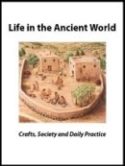
Tabitha in the Bible: In his painting “Raising of Tabitha,” Giovanni Francesco Guercino depicts the moment when Peter resurrects Tabitha. In the Bible, this episode is described in Acts 9:36–43. Tabitha is portrayed as a woman leader in the early Christian church.
What was life like for women in the early Christian church? What roles were they able to fill? How were women leaders regarded in the New Testament?
While the majority of the leaders of the early Christian church were men, the New Testament describes several prominent women leaders as well. Teresa Calpino analyzes two of these women—Tabitha and Lydia—in her Biblical Views column “Tabitha and Lydia—Models of Early Christian Women Leaders” in the July/August 2016 issue of Biblical Archaeology Review. Teresa Calpino is an Instructor in the Department of Theology at Loyola University Chicago and the author of the recent book Women, Work, and Leadership in Acts (Tübingen: Mohr Siebeck, 2014). Both in her column and in her book, Calpino looks at the dynamic, exemplary figures of Tabitha and Lydia in the Bible.


Lydia in the Bible: This Greek Orthodox painting depicts Lydia. In the Bible, Lydia is described as a “seller of purple cloth” and served as a leader in the early Christian church. She came to be viewed as a saint by many Christian denominations.
Acts 9:36–43 introduces us to Tabitha. In the New Testament, Tabitha is the only woman to be called a disciple. She is described as being “devoted to good works and acts of charity” (Acts 9:36). Lydia appears in Acts 16. Described as “a dealer in purple cloth,” Lydia is a successful businesswoman—and very hospitable (Acts 16:14). After converting to Christianity, she opens her home to Paul and his companions.
Both Tabitha and Lydia filled leadership roles in the early Christian church. They were important pillars of their communities, and they are described positively in the New Testament. In her column, Teresa Calpino explores whether it was common for women to fill leadership roles in the Roman world. Did Lydia and Tabitha in the Bible enjoy leadership opportunities within the Christian community that were available to others in different social and religious communities?
While this is a complex issue, Calpino demonstrates that women leaders were not unique to the church. Although they were by no means the norm, there are examples of prominent women businesswomen, intellectuals and community leaders throughout the Roman world.
To learn more about Tabitha and Lydia in the Bible, read the full Biblical Views column “Tabitha and Lydia—Models of Early Christian Women Leaders” by Teresa Calpino in the July/August 2016 issue of Biblical Archaeology Review.
Not a subscriber yet? Join today.

Related reading in Bible History Daily:
Tabitha in the Bible by Robin Gallaher Branch
Judith: A Remarkable Heroine by Robin Gallaher Branch
Anna in the Bible by Robin Gallaher Branch
This Bible History Daily feature was originally published on August 8, 2016.
Get more biblical Archaeology: Become a Member
The world of the Bible is knowable. We can learn about the society where the ancient Israelites, and later Jesus and the Apostles, lived through the modern discoveries that provide us clues.
Biblical Archaeology Review is the guide on that fascinating journey. Here is your ticket to join us as we discover more and more about the biblical world and its people.
Each issue of Biblical Archaeology Review features lavishly illustrated and easy-to-understand articles such as:
• Fascinating finds from the Hebrew Bible and New Testament periods
• The latest scholarship by the world's greatest archaeologists and distinguished scholars
• Stunning color photographs, informative maps, and diagrams
• BAR's unique departments
• Reviews of the latest books on biblical archaeology
The BAS Digital Library includes:
• 45+ years of Biblical Archaeology Review
• 20+ years of Bible Review online, providing critical interpretations of biblical texts
• 8 years of Archaeology Odyssey online, exploring the ancient roots of the Western world in a scholarly and entertaining way,
• The New Encyclopedia of Archaeological Excavations in the Holy Land
• Video lectures from world-renowned experts.
• Access to 50+ curated Special Collections,
• Four highly acclaimed books, published in conjunction with the Smithsonian Institution: Aspects of Monotheism, Feminist Approaches to the Bible, The Rise of Ancient Israel and The Search for Jesus.
The All-Access membership pass is the way to get to know the Bible through biblical archaeology.
The post Lydia and Tabitha in the Bible appeared first on Biblical Archaeology Society.

0 Commentaires